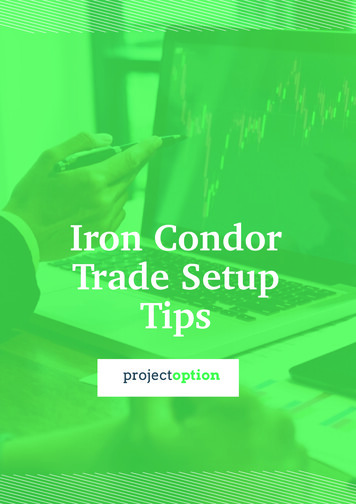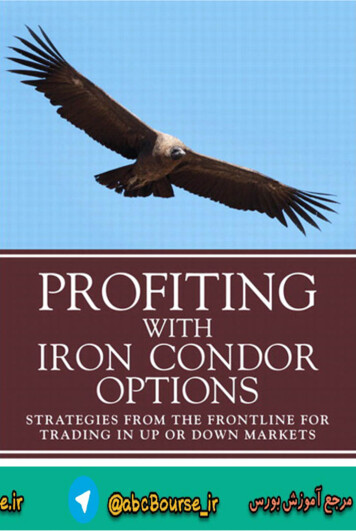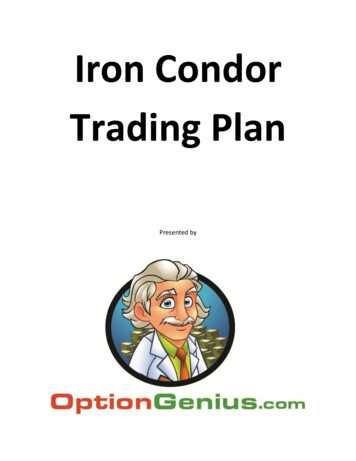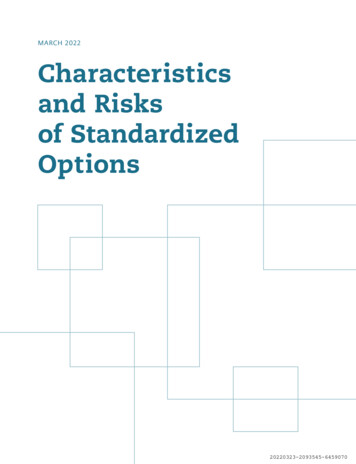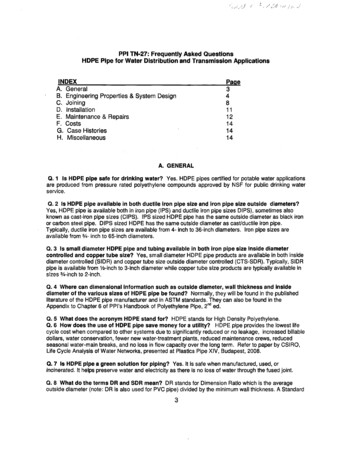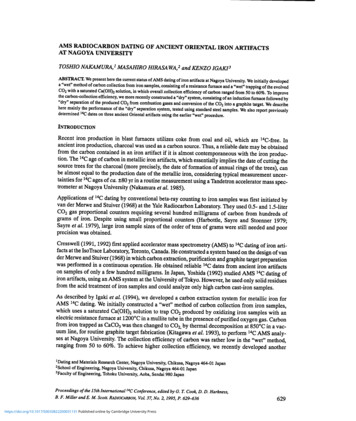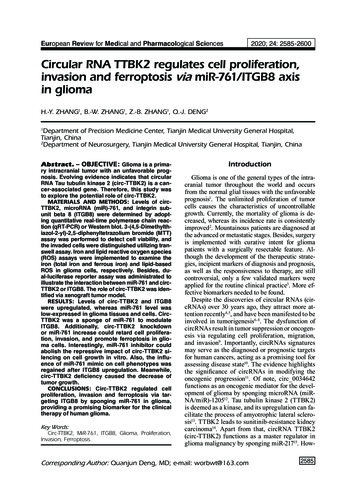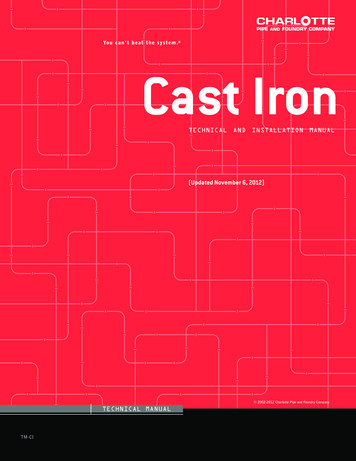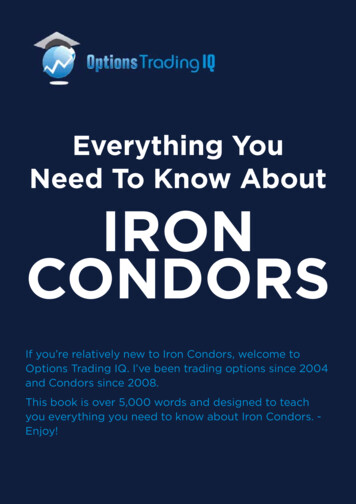
Transcription
Everything YouNeed To Know AboutIRONCONDORSIf you’re relatively new to Iron Condors, welcome toOptions Trading IQ. I’ve been trading options since 2004and Condors since 2008.This book is over 5,000 words and designed to teachyou everything you need to know about Iron Condors. Enjoy!
ContentsINTRODUCTION. 1BEAR CALL SPREAD.2PUTTING IT ALL TOGETHER.3WHEN TO ENTER IRON CONDORS. 5AFTER A RANGE EXPANSION.5ON A VOLATILITY SPIKE.6BASED ON IV RANK.6ANY TIME?.7LONG-TERM OR SHORT-TERM IRON CONDORS. 9SLOW MOVERS.9UNDERSTANDING CONTANGO AND BACKWARDATION. 12THE “VOLPOCALYPSE”. 12LEGGING IN TO AN IRON CONDOR.14RISKS OF LEGGING IN TO IRON CONDORS. 14SELECTING IRON CONDOR STRIKES.15DELTA DOLLARS MAY BE THE SINGLE MOST IMPORTANT METRIC TO LEARN.16WHY IS IT IMPORTANT. 16PRACTICAL EXAMPLE. 17DELTA HEDGING.18SHOULD YOU TRADE INDEX OR ETF OPTIONS?.20LIQUIDITY. 20SETTLEMENT. 20COMMISSIONS. 21TAX. 21CAPITAL LEVEL. 21DIVIDENDS. 21EARLY ASSIGNMENT. 21HOW TO TRADE IRON CONDORS WITH A SMALL ACCOUNT. 23HOW TO SURVIVE A FLASH CRASH. 24UNDERSTANDING GAMMA RISK. 25KEY POINTS REGARDING GAMMA. 25ADJUSTING IRON CONDORS. 26- ii -
ARE 10% RETURNS POSSIBLE WITH IRON CONDORS?. 27APPROPRIATE ALLOCATIONS TO IRON CONDORS. 27IRON CONDOR EXAMPLES. 28BEFORE ADJUSTMENT. 29AFTER ADJUSTMENT. 29BEFORE ADJUSTMENT.30AFTER ADJUSTMENT.30BEFORE ADJUSTMENT. 32AFTER ADJUSTMENT. 32CONCLUSION. 34- iii -
INTRODUCTIONThe Iron Condor strategy is an income strategy thatprofits if the underlying stock or index stays within acertain range over the life of the trade. Over the courseof any trade, stocks can move one of five ways:1.Up a lot2.Up a little3.Sideways4.Down a little5.Down a lotStock investors would make money in the first two of the above five scenarios.Iron condors will make money in the middle 3 situations and sometimes, if they aremanaged well, can make money in ALL of the five scenarios.An Iron Condor is actually a combination of a Bull Put Spread and a Bear Call Spread.The Bull Put Credit Spread strategy involves selling a put option and buying anotherput option with a lower strike price in the same expiry month. As the name suggests,this is a bullish option strategy. Your outlook on the underlying stock is neutral toslightly bullish. Let’s looks at an example:ABC stock is trading at 47.50 in September. A trader thinks that ABC will not fallbelow 45 before October options expiration. He enters a Bull Put spread by sellingan October 45 put for 2 and buying an October 40 put for 1. The net premiumreceived in the traders account is 100 ( 1 x 100 shares per contract).The maximum risk on the trade is 400 ( 5 difference in strike prices, less 1premium received times 100)At expiry, if ABC finishes above 45, the trader keeps the 100 premium for a returnof 20% on capital at risk.-1-
BEAR CALL SPREADThe Bear Call Credit Spread strategy involves selling a call option and buying anothercall option with a higher strike price in the same expiry month. This is a bearishoption strategy. Your outlook on the underlying stock is neutral to slightly bearish.Let’s looks at an example:ABC stock is trading at 47.50 in September.A trader thinks that ABC will not rise above 50 before October options expiration.He enters a Bear Call spread by selling an October 50 call for 2 and buying anOctober 55 call for 1. The net premium received in the traders account is 100 ( 1 x100 shares per contract).The maximum risk on the trade is 400 ( 5 difference in strike prices, less 1premium received times 100)At expiry, if ABC finishes below 50, the trader keeps the 100 premium for a returnof 20% on capital at risk.-2-
PUTTING IT ALL TOGETHERPlacing the above two trades together creates and Iron Condor. In this example, thetrader is betting that ABC will stay somewhere between 45 and 50 between nowand October expiration. If that occurs, the trader keeps the total 200 in premium.One advantage of Iron Condors is that you can essentially receive double the incomefor the same amount of risk. If you place the Bull Put Spread or Bear Call Spread inisolation, the maximum risk would be 400. If you placed both at the same timeto create an Iron Condor, your capital at risk slightly less because of the 2 lots ofpremium you are bringing in.Let’s look at the details of an Iron Condor using the above examples:Maximum Profit 200Maximum Loss 300Potential Return 66.67%-3-
-4-
WHEN TO ENTER IRON CONDORSAFTER A RANGE EXPANSIONThe market goes in ebbs and flows. Sometimes there isrange expansion and sometimes markets are pretty flatand benign.After one comes the other. If we experience and extended period of contraction, thensoon after we will see a period of expansion.After a big period of expansion, comes a period of contraction. That’s when Condorscan do well.In the chart below, you can see there was a massive range expansion in November2016 coinciding with Donald Trump’s surprise election win. The Bollinger Bands blewout to the widest they had been in a long time.What happened after that?RUT stayed in a range between 1350 and 1450 for the best part of eight months!Yes, Condor traders, myself included, suffered losses in November 2016, but whatfollowed was one of the best periods on record for Iron Condor traders. If a newtrader gave up after November just because they had a bad loss, they would havemissed eight months of good times.-5-
ON A VOLATILITY SPIKEThese are short Vega trades. We’re selling vol, so we want to open trades when vol ishigh. Sell high, buy low. The caveat to that is that sometimes we’ve seen some prettyaggressive V-shaped reversals which is where some traders have gotten into trouble.We get a big drop in the market and a massive vol spike and they think, “Great, vol issuper high, this is a perfect time for an Iron Condor”. But, sometimes that’s not thecase and it can even be the worst time to enter.If markets have a big V-shaped reversal, then the call side of an Iron Condor is goingto come under pressure pretty quickly. I’ve seen it many times in recent years.A good idea is to what a week or two after those big vol spikes, you don’t necessarilywant to get the absolute top in volatility.A great place to find volatility data iswww.ivolatility.com. I use it every day and you can get most of the data you need forfree, or by providing your email address.The below chart shows the implied volatility and historical volatility for RUT.BASED ON IV RANKThrough the use of a measure called the implied volatility rank, you can determinewhether the implied volatility is high or low relative to what it was in the past andeven relative to other options.The way it works is that an option’s current implied volatility is compared against thehistoric range of implied volatilities for that option. Then a rank is assigned between0 (minimum) and 100 (maximum).-6-
This rank shows how low or high the current implied volatility is compared to where ithas been at different times in the past.As an example, say you had six readings for implied volatility which were 10, 14, 19, 22,26 and 30. You’ve just calculated the current implied volatility and it is 10.In this example, it would be given a rank of 0 since it is equal to the lowest value inthe range.If instead the current implied volatility was 30, it would be given a rank of 100 as it isequal to the highest value in the range.A good free scanner for IV Rank is available from www.marketchameleon.com. Youcan access this data for free and can be a good way to find trade ideas. They alsohave a scanner for low IV Rank stocks.You can find a more detailed guide on IV Rank here.ANY TIME?There’s an argument to be said that you should trade them in a consistent mannerever week or every month. There will be good period and there will be bad period,like any trading strategy. But over the long run, the probabilities should play out.One of the worst things you can do is quit trading Iron Condors after a bad period,because chances are a good period is right around the corner.Likewise, don’t get too cocky after a good period, because your next losing trade isprobably not far away.Consistency is the key to success.Scaling in to trades can be a good idea. Rather than going in with 100% position sizeon day 1, start with 25% size and then each week, open the next 25% until you’ve built-7-
the full position.You can also do the same on the way out. Rather than exit the whole position atonce, take it off in 25% increments.-8-
LONG-TERM OR SHORT-TERM IRONCONDORSI tend to generate a lot of controversy when I share thisopinion, but I much prefer long term iron condors toshort term condors.Part of the reason for switching to longer terms condors was out of necessity. Movingback to Melbourne where the time difference is an issue, I needed a much lowermaintenance method of trading.Long term condors move very slowly in comparison to their short term counterpartsso they have proven perfect for my timezone constraints.SLOW MOVERSI like to share an example from March 2018 to illustrate the point. RUT dropped 2.18%on March 20th with an associated spike in volatility. That’s just about the worst thingthat can happen to an iron condor the day after you enter it.Let’s look at 3 different condors to see how they performed:Monthly Condor with Delta of -16Weekly Condor with Delta of -1290 Day Condor with Delta of -10Give that the monthly condor had the highest negative delta, you might think thatone would perform the best in a falling market, but the results might surprise you.Here’s how the trades looked after the next day:Monthly Condor down 550-9-
Weekly Condor down 2,15090 Day Condor up 100- 10 -
You can see the 90 day condor performed by far the best out of the 3. Yes, the tradeoff is slower time decay and lower profits in quiet markets, but I’ll take that in returnfor reduced P&L volatility.In situations like this, the weekly condor is in real trouble, the monthly condor mightneed to be adjusted but the 90 day condor can just be left alone to do its thing.Everyone has their own preference and trading style, but for me, I find the long-termcondors suit my style much better than the shorter-term condors.- 11 -
UNDERSTANDING CONTANGO ANDBACKWARDATIONAny discussion about short-term and long-term IronCondors wouldn’t be complete without a discussion onContango and Backwardation. Fun stuff this is!So, funny names, but important concepts.Contango and Backwardation refer to the shape of the volatility term structure. Youcan find the full details at oknow-about-vix-term-structure/, but the general idea is that the level of impliedvolatility is different for each different option expiration period.The normal situation is that volatility is lower in the front months and the backmonths are higher. This makes sense if you think about, because the further out intime you go, the more chance that a volatility event can occur, so traders want to becompensated for that risk. This situation is called Contango and occurs most of thetime in the market, particularly during bull markets.The opposite occurs when the market experiences a volatility event. The volatilityin the front months skyrockets while the back months don’t rise as much. This isbecause the market knows that panics usually die down within a few weeks andthings return to normal.VIX Term Structure is important because it tells us a lot about the current state of themarket.When the Term Structure is in Contango, markets are in a calm state and arebehaving normally.When we shift to Backwardation, markets are in panic mode.Sometimes panics can reverse quickly such as during Brexit, but other times themarket can remain in Backwardation for an extended period such as during thefinancial crisis of 2008.Yes, taking a contrarian view can be profitable when markets panic, but we also needto be aware that some of the worst market declines in history have come AFTER theVIX Futures market moved into Backwardation.THE “VOLPOCALYPSE”Here’s an example from February 2018 when VIX spiked an almighty 115.6% from 17.31to 37.32.The previous biggest spike (excluding the 1987 crash because VIX didn’t exist then)was 64.20% in February 2007.Just let that sink in for a minute.- 12 -
The spike was nearly twice as big as the previous biggest spike. It literally wiped outtraders by the thousands and even saw the collapse of a few volatility ETF’s.Below, you can see what happened to the VIX Term Structure on that day.You can see that the market went from Contango to Backwardation and the impactof the volatility spike was greatest in the front month options. The back monthsweren’t impacted much at all.Now you might realize why I prefer long-term Iron Condors!- 13 -
LEGGING IN TO AN IRON CONDORWhen I’m entering an iron condor trade, I like to waituntil one of the verticals gets filled and then quicklymake sure the other one gets filled.Legging in is the process of selling one of the verticals and waiting for the stock tomove (hopefully in your direction) before entering the other vertical.Legging in to an iron condor offers the potential for higher returns, but it also comeswith higher risk.RISKS OF LEGGING IN TO IRON CONDORSThere are risks with any trading strategy and the same goes for legging in to ironcondors.If a trader is bullish they might start by selling a bull put spread. Then, if the marketdeclines, that spread is placed under pressure with no offsetting gains from thedeclining price of the bear call spread.However, the opposite is also true. If the market rallies, the trader makes all the gainsfrom the declining put spread with no offsetting loss on the call spread.- 14 -
SELECTING IRON CONDOR STRIKESThere are number of different factors you could take intoconsideration when choosing strikes on your iron condortrades. Some people tend to over analyze and then areovercome with analysis paralysis. Others try to take arules based approach and take the emotions out of thedecision making process. For those suffering from thedreaded analysis paralysis, let’s see if we can come upwith some pretty standard rules for iron condor entry.There are 3 main ways to choose the short strikes:1.Use delta. I.e. Sell 10 delta or 15 delta2.Use standard deviation. i.e. sell strikes 1 or 2 standard deviations away from thecurrent price3.Use technical analysisUsing a combination of all three makes sense, but you also don’t want toovercomplicate things. Some traders will just sell 15 delta iron condors no matterwhat. There is nothing wrong with that.Personally, I use delta as the main criteria and tend to place the short strike around a10-15 delta.- 15 -
DELTA DOLLARS MAY BE THE SINGLEMOST IMPORTANT METRIC TO LEARNDelta is one of the four main option greeks, and anyserious trader needs to have a thorough understandingof this greek if they hope to have any chance of successin the trading options.Delta dollars is quite simply the position delta x the underlying price.We know that delta gives us the share equivalency ratio, so if we own a long call withdelta 0.40 it is equivalent to being long 40 shares of the underlying.Let’s assume the stock is trading at 100. The delta dollars figure would be 40 x 100 4,000.This tells us that the option position is equivalent to having 4,000 invested in thestock.The delta dollars figure is going to depend a lot on the price of the stock. Let’s saythat instead of the stock trading at 100, it was trading at 500. Our delta dollarsfigure in this example would be 40 x 500 20,000.Perhaps now you can understand why it’s important to look at the delta dollarsnumber and not just the delta.WHY IS IT IMPORTANTDelta dollars tells us our overall directional exposure in the market.If our account size is 50,000 and out delta is 100, that doesn’t really tell us much.But if our delta dollars exposure is 200,000 then we know that it is too high for ouraccount size.Personally, I like to set a rule that I don’t let my delta dollar exposure get above 150%of my account size. More conservative traders might like to set that rule at 100%,whereas more aggressive traders might set it at 200%.It’s personal preference, but the first step as a delta neutral trader is to start payingattention to delta dollars and then develop rules around this metric.I also have rules regarding the delta dollar exposure for each trade and strategy.- 16 -
PRACTICAL EXAMPLEFor an iron condor, I usually set a 200% rule for Delta Dollars.Assume you have an iron condor on RUT that is risking 20,000. If the Delta Dollarsfigure gets above plus or minus 40,000 you might want to think about adjustingand getting back closer to neutral.- 17 -
DELTA HEDGINGSometimes markets move really quickly and it leaves uslittle time to adjust our positions.Here’s a quick and easy strategy I use to cut my exposure and stem the bleedingwhile I figure out whether I want to adjust or close the main position.Let’s say we have the following Iron Condor that is showing too much positive Deltaas the market is falling.Assuming we decide we don’t want to adjust the Condor, and we want to give it abit more time to see if the market will bounce. But, we are concerned that furtherdownside will see our losses start to pile up pretty quickly.In that case, we can simply buy 1 put option to neutralize the Delta.You can see above that the net position Delta is 20. So we simply buy a 20 Delta putand voila, we’re back to Delta neutral.- 18 -
If the market continues to fall, the long put acts as a hedge and will reduce the losseson the Condor.If the market rallies, we can sell the long put for a small loss, it’s done it’s job and it nolonger needed.Delta hedging can get a lot more advanced than this, but this gives you a quickinsight into how the process works.- 19 -
SHOULD YOU TRADE INDEX OR ETFOPTIONS?Trading options on the main US indicies is growing inpopularity every year. But what are the best ways to dothis? There are two very similar assets to choose from –SPY which is an Exchange Trade Fund and SPX which isan Index. Both are very popular with great liquidity, butwhat’s the difference?Let’s take a look at some of the factors when considering “Should I trade indexoptions or ETF option?”LIQUIDITYLiquidity is a huge consideration when trading Iron Condors. Slippage can really eatinto your profits and it takes some practice and experience in order to get good fills.Also, opening a trade is one thing. When markets tank, the bid – ask spread widenssignificantly and you can get killed trying to get out of a position quickly.Traders who are worried about liquidity, or are just starting out, should stick to theETF’s as there will be less slippage.When comparing liquidity on the major indexes, there is not much differencebetween index options and ETF options as both are very, very liquid.SETTLEMENTTrading Index options occasional provides a risk due to the settlement process. Theway it works is this.The monthly options cease trading on Thursday at 4pm, BUT the final settlementprice is calculated based on the prices that each stock in the index opens at onFriday.So, if there is a big gap up or down on the Friday morning the final settlement valuecould be significantly different to what you would expect based on Thursday’s close.This can cause a problem if you are holding an Iron Condor that is close to themoney, a big gap up or down could mean that your sold option finishes in-the-moneyon settlement even though you were nice and safe when the market closed on theThursday.The only way to 100% eliminate this risk is to close out the options on the Thursdaybefore the close.I would usually do this if the index was within 1-2% of my strike prices just to be on- 20 -
the safe side.COMMISSIONSThere are a lot of brokers offering commission free trading these days socommissions are less of factor than they used to be. However, there are still optioncontract fees to consider, so larger traders might prefer to trade SPX rather than SPYso they trade less contracts.TAXIndexes have preferential tax treatment and as such may be more suitable for largertraders. Income from index options is treated as 60% long term and 40% short term,regardless of the trade duration.Income from ETF options is treated the same as stock. As Iron Condor are short termtrades of between 15 and 60 days, index options will be more advantageous from atax perspective.CAPITAL LEVELThe SPY ETF is approximately 1/10 the value of the SPX Index.Those with a smaller capital balance may be better off trading SPY, as trading SPXmay mean their capital at risk is too high.DIVIDENDSWhile not a huge consideration, ETF’s pay dividends while index’s do not. When anETF goes ex-dividend, the price usually drops by the amount of the dividend.This is something that you may need to take into consideration when selecting yourstrikes. ETF traders would also need to keep an eye on this close to expiration due toearly assignment risk as discussed shortly.EARLY ASSIGNMENTEarly Assignment is only an issue for American style options.Stocks and ETF’s are American style, while indexes are European style.If you are trading Iron Condors and credit spreads on the indexes (RUT, SPX, NDX andMNX), you don’t even need to worry about it.For those you trade the ETF’s (IWM, SPY and QQQ) there is a risk of earlyassignment but the risk is incredibly low and almost not worth worrying about.The main reason to exercise an option early is to receive the dividend, and the optionwould have to be deep in-the-money to do that.If you are trading American style options, the most important thing is to not let yourshort options go in-the-money and keep an eye on dividend dates.- 21 -
- 22 -
HOW TO TRADE IRON CONDORS WITHA SMALL ACCOUNTBeginner traders sometimes shy away from optionstrading and iron condors in particular because they areworried they can’t do it effectively with a small account.Ideally, you want to have around 5,000 to 10,000 at a minimum to start tradingoptions.You can even start trading with as little as 2,000. In fact, in some respects, it’s betterto start with a small account while you are learning. That way, if a trade goes bad youhaven’t done too much damage to your net worth.Even if you have 200,000 available for trading options, just start with 10,000and get a feel for how things work. Then, when you’ve been trading for a year or so,SLOWLY build your account from there.You don’t want to jump from 10,000 to 200,000 overnight.The psychological aspect of trading a 200k account is much different to a 10kaccount.Iron Condors are risk defined trades. The required capital for a trade is equal to themaximum loss. Unless the market makes a catastrophic move, you are unlikely tosuffer a max loss on a trade. The only time that would happen is if a trader is toostubborn to stick to a stop loss.Over the long-term, trading an options-based portfolio with a small accounts requirestraders to stick to pretty well defined rules and trading plans. No flying by the seat ofyour pants please!Below are some of the key concepts to consider when trading iron condors with asmall account:1.Set the probability of success in your favour to ensure a statistical edge2.Only open Condors on underlying assets with a high IV Rank3.Stick to the most liquid instruments (SPY, AAPL etc)4.Be consistent in your process5.Use appropriate position size to manage risk exposure6.Use ETF’s instead of individual stocks to mitigate earnings risk7.Keep an adequate cash buffer for adjustments (30-40%)8.Avoid weekly options9.Have a strict stop loss. Don’t let losses blow out!- 23 -
HOW TO SURVIVE A FLASH CRASHOne of the first things people ask when they learn aboutIron Condors (and I had the same question when I firstlearned about them), is “what happens during a marketcrash?”At the end of the day, all trading is risky, no matter the strategy.Finance 101 tells us that the higher the return we are aiming for, the more risk wemust be taking. If you’re aiming for 5% returns per months, that equates to 60% peryear. That’s better than Warren Buffett and most hedge fund managers.So, the first step is to have realistic expectations of returns and not take on too muchsome.Other ways to manage the risk of a Flash Crash are:1.Use stop losses2.Buy VIX call options3.Buy further out-of-the-money puts4.Delta HedgeYou can read about these concepts in more detail here.- 24 -
UNDERSTANDING GAMMA RISKGamma is the ugly step child of option greeks. You know,the one that gets left in the corner and no one pays anyattention to it? The problem is, that step child is goingto cause you some real headaches unless you give it theattention it deserves and take the time to understand it.Gamma is the driving force behind changes in an options delta. It represents the rateof change of an option’s delta. An option with a gamma of 0.05 will see its deltaincrease by 0.05 for every 1 point move in the underlying. Likewise, an option witha gamma of -0.05 will see its delta decrease by 0.05 for every 1 point move in theunderlying.KEY POINTS REGARDING GAMMAGamma will be higher for shorter dated options. For this reason, the last week of anoptions life is referred to as “gamma week”. Most professional traders do not want tobe short gamma during the last week of an options life.Gamma is at its highest with at-the-money options.Net sellers of options will be short gamma and net buyers of options will be longgamma. This makes sense because most sellers of options do not want the stock tomove far, while buyers of options benefit from large movements.A larger gamma (positive or negative) leads to a larger change in delta when
The Iron Condor strategy is an income strategy that profits if the underlying stock or index stays within a certain range over the life of the trade. Over the course of any trade, stocks can move one of five ways: 1. Up a lot 2. Up a little 3. Sideways 4. Down a little 5. Down a lot Stock investors would make money in the first two of the above .
